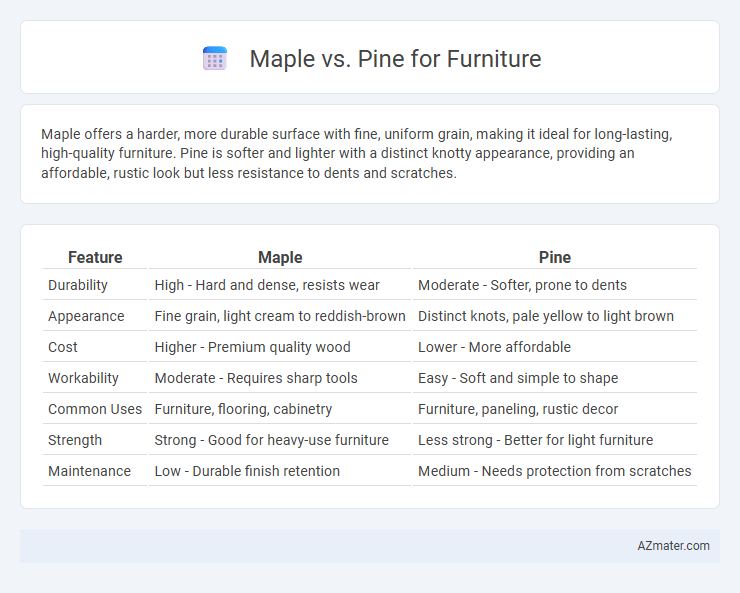Maple offers a harder, more durable surface with fine, uniform grain, making it ideal for long-lasting, high-quality furniture. Pine is softer and lighter with a distinct knotty appearance, providing an affordable, rustic look but less resistance to dents and scratches.
Table of Comparison
| Feature | Maple | Pine |
|---|---|---|
| Durability | High - Hard and dense, resists wear | Moderate - Softer, prone to dents |
| Appearance | Fine grain, light cream to reddish-brown | Distinct knots, pale yellow to light brown |
| Cost | Higher - Premium quality wood | Lower - More affordable |
| Workability | Moderate - Requires sharp tools | Easy - Soft and simple to shape |
| Common Uses | Furniture, flooring, cabinetry | Furniture, paneling, rustic decor |
| Strength | Strong - Good for heavy-use furniture | Less strong - Better for light furniture |
| Maintenance | Low - Durable finish retention | Medium - Needs protection from scratches |
Introduction: Maple vs Pine for Furniture
Maple and Pine are two popular wood choices for furniture, each offering distinct characteristics that influence durability, appearance, and cost. Maple is a hardwood prized for its strength, fine grain, and resistance to dents, making it ideal for high-traffic furniture pieces. Pine, a softer wood, is valued for its affordability, light color, and ease of working, often chosen for rustic or farmhouse-style furniture.
Wood Characteristics: Maple and Pine Compared
Maple wood is dense and durable, featuring a fine, uniform grain that provides a smooth, hard surface ideal for high-traffic furniture pieces. Pine, in contrast, is lighter and softer with a more pronounced grain and knots, making it more susceptible to dents but easier to work with for rustic or casual furniture styles. While maple offers superior strength and longevity, pine adds warmth and character, influencing furniture choice based on both aesthetic and functional preferences.
Durability and Strength Differences
Maple offers superior hardness and strength compared to pine, making it highly durable and resistant to dents and scratches in furniture applications. Pine, being a softwood, is less dense and more prone to dents but remains lightweight and easier to work with. The inherent strength of maple makes it ideal for heavy-use furniture, while pine suits pieces requiring flexibility and a softer aesthetic.
Appearance: Color, Grain, and Texture
Maple furniture features a light, creamy color with subtle reddish or golden hues, providing a smooth, consistent grain that enhances its elegant, fine texture. Pine showcases a pale yellow to light brown color with prominent knots and a more rustic, coarse texture that adds character and warmth to casual or country-style furniture. The choice between maple and pine depends on whether a sleek, refined appearance or a natural, textured look is desired for the furniture piece.
Workability and Ease of Use
Maple offers superior workability due to its fine, uniform grain and hardness, allowing smooth sanding and a clean finish ideal for detailed furniture pieces. Pine, being a softer wood with a more open grain, is easier to cut and shape by hand or machine, making it a preferred choice for beginners in woodworking. Both woods respond well to staining and finishing, though maple's density requires pre-drilling for nails and screws to avoid splitting.
Furniture Styles Suited for Maple and Pine
Maple furniture excels in contemporary and Scandinavian styles due to its fine, uniform grain and smooth finish that complements minimalist designs. Pine is preferred for rustic, farmhouse, and cottage furniture because of its knotty texture and warm, natural character that enhances cozy and casual aesthetics. Choosing maple or pine depends on the desired durability and visual texture, with maple offering strength and sleekness, while pine provides affordability and a more organic look.
Finishing Options: Staining and Painting
Maple wood offers a smooth, tight grain that takes stains evenly, producing rich, vibrant finishes ideal for traditional and modern furniture styles. Pine's softer texture absorbs stains unevenly, often resulting in blotchy outcomes, but it readily accepts paint, making it a versatile choice for colorful and rustic furniture designs. Both woods respond well to clear finishes, but maple's natural hardness enhances durability and longevity under various finishing treatments.
Cost and Availability Analysis
Maple furniture typically costs more than pine due to its durability, fine grain, and hardness, which make it ideal for high-end pieces. Pine is widely available and more affordable, often used for budget-friendly or rustic-style furniture. The cost-effectiveness of pine is balanced by its softer nature and susceptibility to dents, whereas maple's higher price reflects its longevity and resistance to wear.
Environmental Impact and Sustainability
Maple wood, known for its durability and fine grain, often requires more energy-intensive processing compared to pine, which grows faster and sequesters carbon quickly, offering a more sustainable sourcing option. Pine's rapid growth cycle allows for quicker forest regeneration, reducing environmental impact and supporting sustainable forestry practices. While maple is longer-lasting and less prone to damage, pine's renewable nature and lower ecological footprint make it a preferred choice for eco-conscious furniture production.
Maple vs Pine: Which is Best for Your Furniture Project?
Maple offers exceptional hardness and durability, making it ideal for high-traffic furniture pieces that require resistance to dents and scratches. Pine, being a softer wood, is easier to work with and provides a rustic appearance with visible knots and grain, suitable for budget-friendly or decorative furniture. Choosing between maple and pine depends on the need for strength and longevity versus aesthetic warmth and cost-efficiency in your furniture project.

Infographic: Maple vs Pine for Furniture
 azmater.com
azmater.com